The world of mobile photography keeps on evolving with fresh new ideas every minute, but just how far the progress has really gone? Is it really going forward... or going nowhere?
Back in February 2019, HMD Nokia unveiled their latest product during Mobile World Congress (MWC) 2019 in Barcelona. The product in question was the 210 of which was touted by Nokia themselves as "the most affordable internet phone yet", the bigger Plus variant of Nokia 1, the two-day battery life-claimed 3.2, and the Google Assistant-focused 4.2. However, the product that got people continuously talking about was the long-awaited 9 PureView (9PV).
The latest phone to carry the iconic PureView badge, it sported five identical 12MP ZEISS cameras consisting of two RGB lenses and three monochrome lenses alongside a time-of-flight (ToF) sensor. Furthermore, the camera was developed in conjunction with Light, the company that brought out the mad L16 camera. Little wonder then on why everyone were having high hopes for HMD Nokia to regain back their crown in the world of mobile photography. After all, the older Windows Phone-powered PureView devices like the 2013 Nokia Lumia 1020 and the 2015 Microsoft Lumia 950/950 XL can still hold their fight against the newer and latest Android-powered smartphones of today.
The latest phone to carry the iconic PureView badge, it sported five identical 12MP ZEISS cameras consisting of two RGB lenses and three monochrome lenses alongside a time-of-flight (ToF) sensor. Furthermore, the camera was developed in conjunction with Light, the company that brought out the mad L16 camera. Little wonder then on why everyone were having high hopes for HMD Nokia to regain back their crown in the world of mobile photography. After all, the older Windows Phone-powered PureView devices like the 2013 Nokia Lumia 1020 and the 2015 Microsoft Lumia 950/950 XL can still hold their fight against the newer and latest Android-powered smartphones of today.
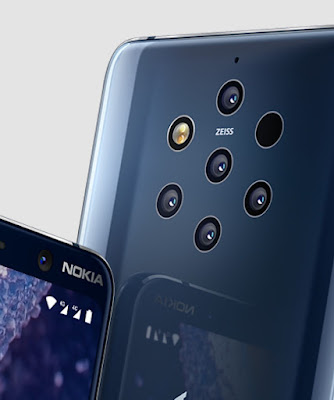 |
| Photo: HMD Nokia |
Right now though, camera performance isn't my concern. What piques my interest in the 9PV is the phone design. According to Juho, all the camera was housed on an 8mm thick body. This meant a super slim design without the need for any camera bump whatsoever.
Let's face it, Juho does have a point. No one wants to see a bump on their smartphone. You certainly didn't want to see your phone not staying flat because of its bulky rear camera, right? Perhaps that Nokia's decision on creating a powerful multi-setup camera under a slim design does sound like perfectly common sense, isn't it? Here's my personal hot take: There is more than just the design.
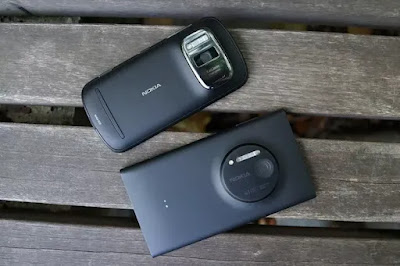 |
| Camera bump of the 2012 Nokia 808 PureView (top) and the 2013 Nokia Lumia 1020 (bottom). Photo: The Verge |
Even for a mobile photography aficionado like me, there is no getting away from the fact that smartphone cameras still have a long way to reach the equal photo quality level of a proper DSLR camera despite various innovations. LG and Apple started the multi-camera trend despite earlier attempts by HTC, Samsung gave us the Dual Pixel autofocus, Google invented the night mode photography with Night Sight, and Huawei wowed everyone with the RYYB SuperSpectrum and Hybrid Zoom technology for their latest P30 and P30 Pro.
Impressive though they all sound, they were all made for software processing, especially with AI in the equation. Software processing is spelt for computational photography. The idea is that a photo is taken through rigorous algorithms of the camera's imaging software to create an output equal to a proper DSLR or Mirrorless camera.
The problem, however, is that smartphone cameras tend to have rather small sensors. In the case of the 9PV, all the identical 12MP cameras have a sensor size of 1/2.9". That is way less than you find in a 1-inch Mirrorless, let alone a proper Full Frame DSLR camera. To give you a perspective of how big (or small) that sensor is, here's a simple illustration to explain the number.
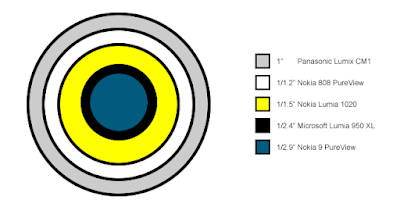 |
| A rough circular illustration of the camera sensor size from a few selected smartphones. |
Here, you can see that the 9PV have the smallest circle (read: sensor) compared to Microsoft Lumia 950 XL alongside some other smartphone of my own personal favourite. At this point, you might be wondering to yourself, "Why should I be bothered with all of this sensor nonsense? As long as my phone can take a nice photo, that's all that mattered right?"
Here's the thing: When it comes to mobile photography, I always personally believe that there is one area where smartphone cameras always struggle the most: low light photography.
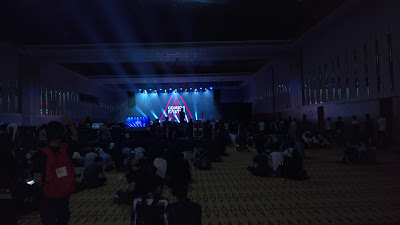 |
| A view inside the concert stage hall during Comic Fiesta 2018 (#CF2018). This photo was taken by yours truly using a Microsoft Lumia 950 XL without any edit whatsoever. |
For me, low light conditions have always been the ultimate true test in mobile photography. This is where you can see whether physics or AI delivers the best image processing. Sure that Google gave us Night Sight as mentioned earlier, but that doesn't mean they are the real winner. A similarly low light photo taken from a phone with a larger sensor and manual setting (i.e shutter speed) without any AI interference may take an equally good, if not even better photo than the one with software and AI trickery.
- But, how relevant camera sensor is when it comes to dark places?
Put it simply, it's all about light and details. The bigger the camera sensor, the more area the light can gather inside the sensor. In return, you got more details captured in the camera. This prevents the camera from generating a very noisy image with a high ISO value.Going back to the rough circular illustration from earlier, you get the impression that the 9PV cannot gather the same amount of light compared to, say, the Nokia Lumia 1020. This meant that under the low light conditions with identical manual settings, the 9PV would produce a darker photo than the Lumia 1020. To prove this point, I had devised a simple demonstration.
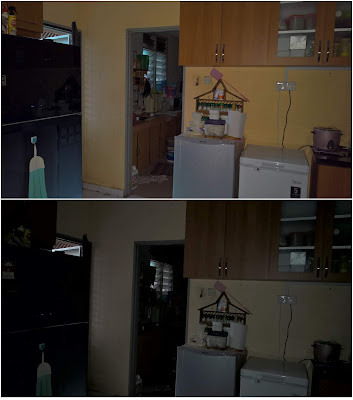 |
| Same place, same time, two completely different results. |
What we have here are two photos that were captured by yours truly at the same time in the same place with the same ISO and exposure value. Both photos are capped at 8MP 16:9 resolution (3840 x 2160). You may have already noticed that the photo on the bottom is darker than the one on the top. Just to kill your curiosity about which phone took which photo, here are the phone in question.
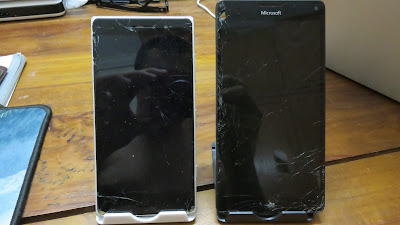 |
| I do apologize about the cracked screen from both phones since I am not thinking about replacing the screens as I write this blog post. After all, they still work like a charm. |
On your left is the 2014 Nokia Lumia 830, and on your right is the 2015 Microsoft Lumia 950 XL. Both smartphones were produced by Nokia under the ownership of Microsoft. The main focus between these two smartphones is the PureView bit - the 830 sported a 10MP 1/3.4" sensor with f/2.2 aperture, while the 950 XL was equipped with a 20MP 1/2.4" sensor with f/1.9 aperture.
From the mentioned spec, you realized that the sensor in the 830 is much smaller than the 950 XL. In fact, it was even smaller than the sensors in the 9PV. As a result, the 830 produced a much darker photo than the 950 XL as shown with the photo comparison from earlier. Also, I really am not joking about the same ISO and exposure value.
 |
| Here you go, same ISO and exposure value as proven. |
Look, I know that comparing a flagship-tier smartphone with triple LED RGB flash to a midrange with a single LED flash sounds a bit of a cheat, not forgetting the different aperture value. But even if both of them have the same type of flash and the same aperture value, the end result would not be the same if they use a different sensor. It was only when you placed the two phones side-by-side upside down that you really began to see the sensor difference. Even though the bump on the 950 XL looks tiny, that is enough to show that Nokia and Microsoft are serious when it comes to camera hardware. After all, what is the point of having a flagship-tier smartphone if you don't have a flagship-tier camera?
With smartphone brands of today focusing on giving all-around versatility to consumers, it's all about choosing the best multi camera setup. One would go for monochrome and/or depth sensor, while another one goes all-out with ultrawide and telephoto zoom. Now that there is the rise of pixel binning technology, OEMs like Samsung and Sony are now chasing the megapixel race once again hoping that we can finally reach the point of having a DSLR-like photo quality from the palm of our hand.
Whichever route the brands choose, the software side will be the main focus. It feels as if the consumers don't want to see a large camera bump on the back of their phone or that they are not that interested in the engineering behind the camera technology as long as it looks good on social media, particularly Instagram. I honestly believed that we are actually going nowhere in terms of photo quality. Yes, there are vast innovations created by smartphone brands, but what is the point of those innovations if the photo we got looks like a Photoshop painting of a seven-year-old child?
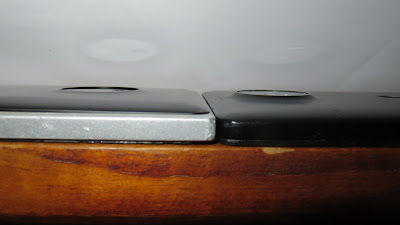 |
| The rear of Lumia 830 (left) and Lumia 950 XL (right) facing upwards with cover attached. |
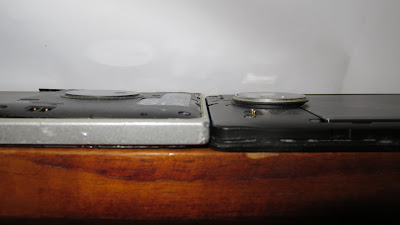 |
| The rear of Lumia 830 (left) and Lumia 950 XL (right) facing upwards without cover. |
- So what's the toast here?
With smartphone brands of today focusing on giving all-around versatility to consumers, it's all about choosing the best multi camera setup. One would go for monochrome and/or depth sensor, while another one goes all-out with ultrawide and telephoto zoom. Now that there is the rise of pixel binning technology, OEMs like Samsung and Sony are now chasing the megapixel race once again hoping that we can finally reach the point of having a DSLR-like photo quality from the palm of our hand.Whichever route the brands choose, the software side will be the main focus. It feels as if the consumers don't want to see a large camera bump on the back of their phone or that they are not that interested in the engineering behind the camera technology as long as it looks good on social media, particularly Instagram. I honestly believed that we are actually going nowhere in terms of photo quality. Yes, there are vast innovations created by smartphone brands, but what is the point of those innovations if the photo we got looks like a Photoshop painting of a seven-year-old child?
That is why I still believe that hardware physics can still beat software algorithms. Sure that you may have to sacrifice the phone's aesthetics, but let me put it this way: a 4-cylinder modern day sports car with modern electronic aids is no guarantee to be equally fast or faster than a V8 super saloon without any electronic interference whatsoever. Sure that the electronics made the driving much easier and more bearable, but the old-school pure mechanical approach can still beat it if you know what you are doing.
If we apply that analogy to today's smartphone camera, the engine is the camera sensor. You get the sense that the multi-camera progress of today aren't still doing enough justice compared to the olden days where it's all about camera bumps and big sensors. Remember that rough circular illustration from earlier? As of April 2019, there are no other smartphones, including the latest Huawei P30 Pro, that surpass the sensor size of the Lumia 1020. Only the 808 PureView and the Lumix CM1 managed to beat the Lumia 1020, and they were from 2012 and 2014 respectively.
Going back to Juho's point about the 9PV's super slim design without camera bump, credit to them for achieving such feat despite having five cameras and a ToF sensor on board. But personally speaking, I would rather have a large bump with a larger sensor rather than no bump with more cameras but tiny sensors. It seems that we are still far away from the "DSLR photo quality in the pocket" reality.
Do you believe in computational supremacy or still prefer outright physics? Let us know in the comment section down below.


Nice Blog !! Keep it goin'.
ReplyDeletePost a Comment
What do you think of this post? Share your thoughts with us.